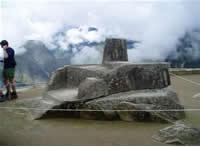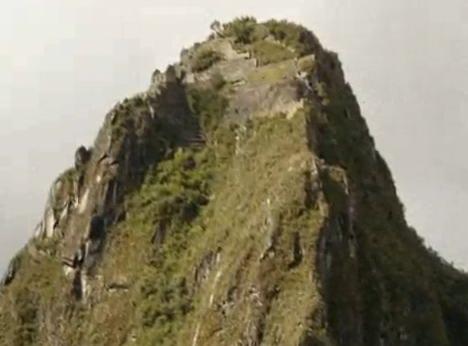Since it was discovered on July 24, 1911 by Hiram Bingham, Machu Picchu has been considered, by its extraordinary magnificence and harmonious structure as one of the architectural and archaeological monuments of the planet’s most important.
2000 Located 400 meters above sea level in the province of Urubamba, department of Cusco, Machu Picchu (Summit Mayor, in Castilian) surprised by the way the stone buildings are deployed on a ridge narrow and uneven in whose edges there is a cliff 400 meters deep, forming the canyon on the Urubamba river reaches.
Citadel shrouded in mystery, because so far archaeologists have not been able to decipher the history and function of this stone city of nearly a mile long, built by the Incas in a magical geographical area, at the confluence of the Andes and the Amazon.
Tourists visiting this natural relic remain convinced that the mystery may never be fully revealed because so far, there are only hypotheses and conjectures. For some, it was an outpost of the Inca expansionist projections, others believe it was a monastery, where they were girls (acllas) to serve the Inca and Willac One (High Priest). This is presumably because of the 135 bodies found in investigations, 109 were female.
The surprising perfection and beauty of Machu Picchu’s walls, built by joining stone to stone without cement or glue-have given rise to myths about its construction.
But beyond the myths, the real charm of Machu Picchu (Cultural Heritage of Humanity by UNESCO in 1983) is in its squares, its aqueducts and watchtowers, its observatories and its sundial, evidence wisdom and technique Andean builders.
However, in recent years has emphasized the care that people should have to visit this place, in fact, most guides agree that precautions are nothing but strategies to prevent early collapse the area.
The concern is also shared by environmentalists and anthropologists from the National University of Cusco, alarmed visitors excess movement causes the stones of the holy city, discovered only in 1911.
The climate of this area has some features are only two distinct seasons and distinguished: the rainy season from September to April and the dry season from May to August.
However, Machupicchu is located at the rim of the Amazon rainforest, and the rains are latent in all seasons. On the hottest days can reach about 26 ° Celsius, the coldest mornings are in June and July where temperatures can drop to -2 ° C. Its average annual temperature is 16 ° C. You can clearly differentiate two seasons: the rainy season (November to March), recommending visitors bring appropriate clothing and sun strong season (April to October), with a significant increase in temperature.
One of the most significant architectural features is that Machu Picchu sits atop a large granite orogenic structure nicknamed “Vilcapampa”.
This, because the white-gray granite is an igneous rock composed mainly with an average of 60% feldspar and 30% quartz, and 10% of mica, which has given a unique six centuries resistance to this construction.
Inca language translates to Machu Picchu as “Old Mountain” in all Andean whole, although it highlights the famous mountain that is seen in front of the photographs, and appears in most classic views of the site is called Waynapicchu (Mountain Young).
Tours and attractions:
There are three known ways to get to Machu Picchu. The first is the traditional (or train), lasting three hours, the second for those who like adventure tourism is the path of the “Inca Trail” hike that requires a great effort for four days. And the ultimate is to get to the town of Aguas Calientes by helicopter. All these tours are hired in Cusco and have an average value of $ 60.
When traveling by train, we must know that there are 112 kilometers away from the city of Cusco and the station of Puente Ruinas or Machu Picchu by train, the journey begins in San Pedro station in Cusco, transmontando Picchu mountain, by zigzagging way until reaching the highest point called “El Arco” in the northeastern part of the city.
Continuing, we descend through the towns of Pory, Cachimatyo and Izcuchaca towards Pampa de Anta, large livestock and indisputable geographical beauty. Roaming through the narrow gorge of Pomatales, slides into the Sacred Valley of the Incas, by Pachar station. You cross the Urubamba River to the right bank to reach Ollantaytambo station and go ahead to Puente Ruinas, final destination.
There are two services: train cars and railcars, which start early and return in the afternoon.
Those in good physical condition can take the route of the Inca Trail to Machu Picchu, which is known as the most famous trekking route in South America by the combination of the different elements that offers visitors. It starts at km 88 of the railway to the Valley of the Convention, in a place called Q’oriwayrachina, there being a total distance of 39 to the sanctuary. 6 kilometers.
To start the walk across the bridge Kusichaca, that as in Inca times was built, like a suspension bridge with steel cables on the Urubamba River. After going through a eucalyptus forest, almost immediately will contact archaeological groups Q’ente, Pulpituyoc, Kusichaca and Patallaca, arriving after several hours walking Wayllabamba where camping is recommended.
The second day is the hardest because it will climb to 4000 200 meters above sea level to lower Pakamayu river valley, where they must spend the night.
While continuing with the walk, the third day, you will notice Runkuraqay archaeological sites as the Yanacocha and Phuyupatamarca lagoon, near the visitor center Wiñayhuayna, where you can camp.
The fourth and final day of adventure, we recommend starting at 8 am, to arrive at Machu Picchu after three hours after crossing the jungle and bordering cliffs.
During each day of trekking you witness an impressive flora and fauna, including endangered species such as the spectacled bear, pumas, Andean foxes, river otters, bobcats and others.
You should carry a sleeping bag or sleeping bag, backpack, utility knife, sickness pills and antivenom.
Surroundings:
Although his visit was banned in the late 90’s, and again you can visit the Temple of the Sun This semicircular building sits on solid rock. In this building there are two trapezoidal windows and according to the chroniclers, at the time it was inhabited, were inlaid with gold and precious stones.
Another attraction is the tours included in the Intiwatana. It is located on a hill formed by several terraces and platforms, which can be reached after climbing 78 steps finely carved. The intiwatana served two functions: measurement time (solstice and equinox) the effect of light and shade and as rock altar.

Huayna Picchu is also that, as explained at the beginning of the story, is located on top of the mountain girl with a rough and small temples. Here’s where it achieves the best view of the citadel. Other attractions are the sacred rock group, The Doors, the fountains and the Mausoleum or Tomb.

In addition, only 800 meters from the village of Aguas Calientes, eastbound, there sulfurous hot springs at different temperatures emerging from bedrock. The pools are conditioned in this place have the basic infrastructure for use as thermal baths. The average temperature of these waters is between 38 and 46 degrees celsius. There are also lobbies, restrooms and a small snack bar.
Suggestions:
Both in the territory and in the companies organizing tours recommend that all persons entering the historic sanctuary of Machu Picchu and makes use of the authorized routes for trekking, must have certain basic standards for the preservation of the area as to avoid contamination environmental waste, campfires, extraction, predation and acquisition of any species of flora or fauna.
